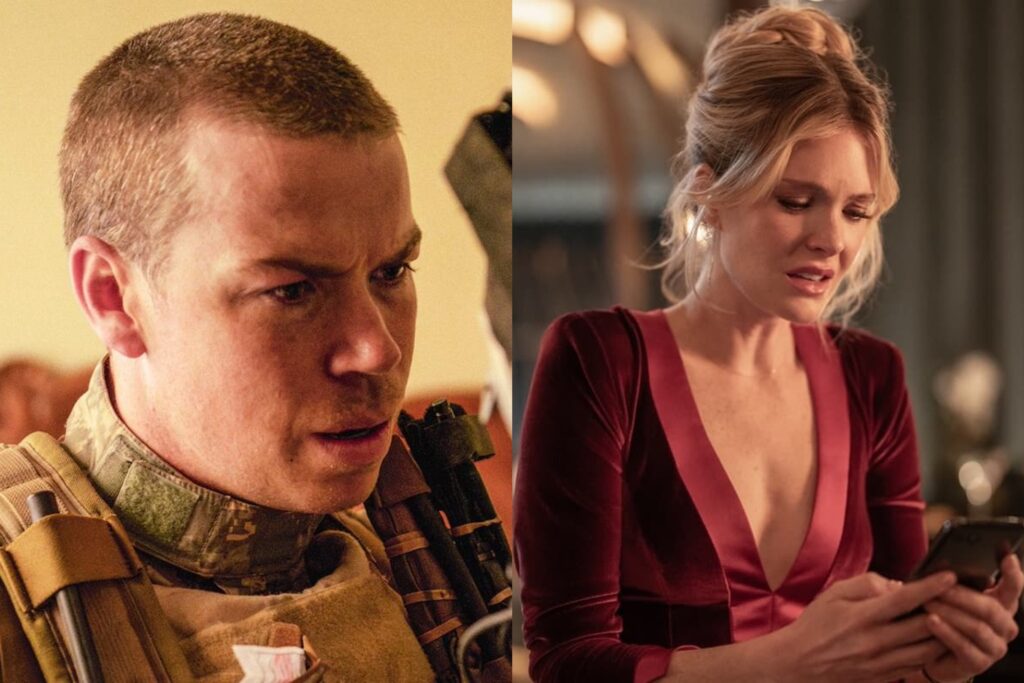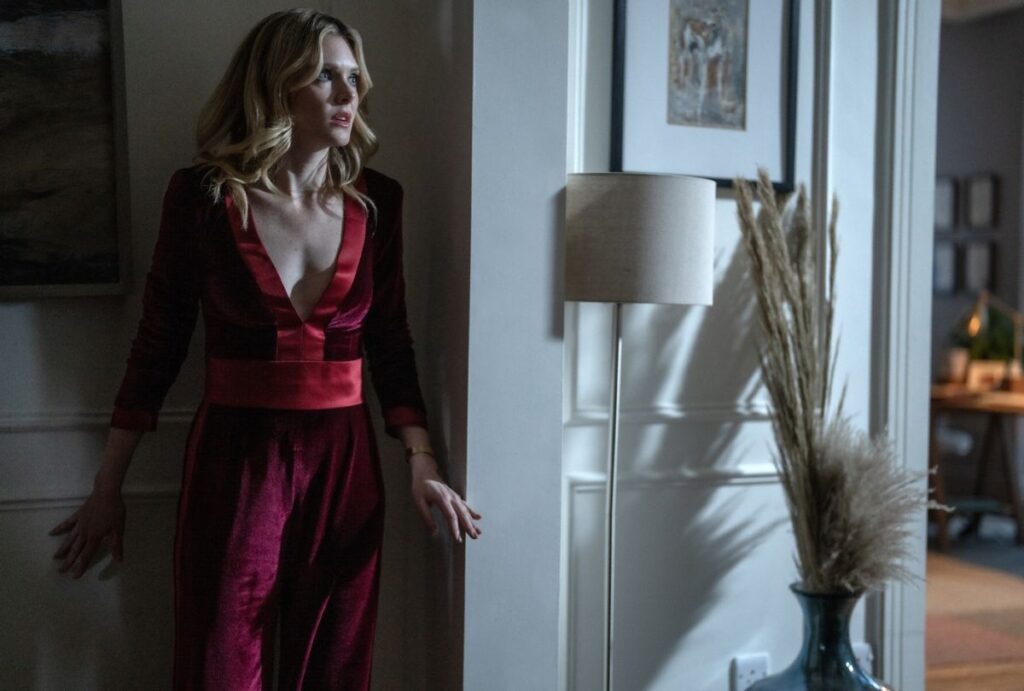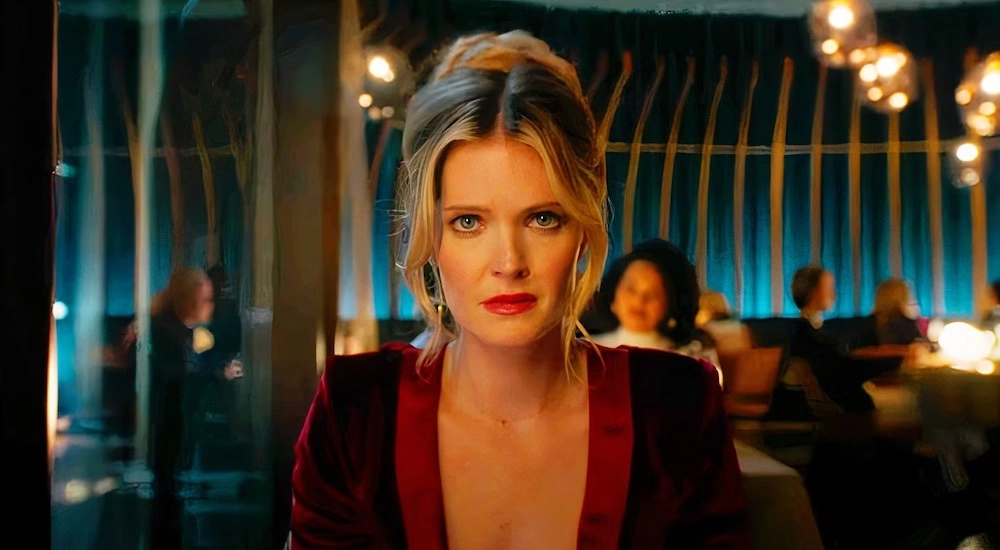
Roger Ebert famously said that the movies are a machine that generates empathy, but that same machine can also manufacture terror. Cinema is an art of forced perspective—we adopt the point of view of a film’s main characters, figuratively if rarely literally—and directors often use the medium to churn our stomachs, to make us experience anxiety and fear. Two of last weekend’s new releases, while occupying different genres and deploying different styles, share the goal of distressing their audience by thrusting you inside their heroes’ nerve-racking headspace. They may ask you to empathize, but they really want you to sweat and shudder.
Of the two, Drop is both the more conventional and the more outrageous. Directed by Christopher Landon from a script by Jillian Jacobs and Christopher Roach, it belongs to an emerging breed of subgenre: the technophobic thriller. Cells phones were supposed to ruin horror movies—why would the final girl cower in fright when she could just call 911?—but filmmakers have adapted, turning tools of salvation into instruments of torment. We spend an increasing percentage of our time interacting with screens; turns out, in addition to distracting us with cute memes, those displays can besiege us with images of our worst nightmares.

Or maybe both at once. The setup of Drop, which hybridizes the claustrophobic anguish of Red Eye with the murder-mystery classicism of Knives Out, is straightforward. Violet (Meghann Fahy), a psychotherapist still recovering from her own episode of domestic abuse, has finally agreed to a dinner date with Henry (Brandon Sklenar, from It Ends with Us), the blandly handsome dude she’s been texting for the past few months. When she arrives at the restaurant, a swanky Chicago spot called Palate, her phone is bombarded with “digi-drops”—a series of message solicitations sent by an unknown user. At first they’re dopey and harmless, a veritable digest of viral images circa 2025. (I caught the Distracted Boyfriend and the Kombucha Girl, though I surely missed others.) But after Violet hits “Accept,” the drops instantly become threatening, showing security footage of her house, where a masked man appears to be stalking her sister and her young son. And you thought weather alerts were annoying.
The challenge of Drop is to bring visual, visceral intensity to a premise—Violet spends most of the movie reacting to notifications on her phone—that’s fundamentally static. Landon, whose prior credits include Freaky and the Happy Death Day flicks, navigates this obstacle fairly well. He indulges in the necessary evil of an explanatory info-dump—Henry describes the logistics of digi-drops to Violet, such as how the sender must be within 50 feet from her—and some of the messages flash past too quickly to be perceived. But once the tone turns sinister—once Violet’s anonymous persecutor demands that she murder Henry in order to save her family—Landon stabilizes a mood of chilly, clammy tension. Some of his flourishes are elegantly simple, like how he renders text in giant capital letters, the words looming over Violet like alphabetic outlaws. He also keeps things moving, constantly presenting Violet with new problems to solve, along with new pieces of information that allow her to mentally investigate an array of potential suspects.

Naturally, there are quite a few of those. Drop is designed to place you alongside Violet as she scrambles to identify and outwit her digital terrorist, even as she largely abides by their commands. Could it be her waiter (Jeffery Self), a dorky improv devotee who’s always lurking nearby? Or maybe the attractive bartender (Gabrielle Ryan) who seems a little too invested in how well her date is going? What about the old guy (Reed Diamond) who bonded with her over their shared unease, or the younger dude (Travis Nelson) who keeps bumping into her, or the piano player (Ed Weeks) who sleazily flirts with her?
For the most part, Landon recognizes that the answer to this all-consuming question is less interesting than the various steps Violet takes to stall, deceive, and obfuscate. Fahy is a sympathetic presence (it doesn’t hurt that she’s decked out in a gorgeous red velvet jumpsuit), and while she effectively conveys Violet’s mental agony, she also communicates her ingenuity and intelligence. Violet is Miss Marple by way of Sidney Prescott, and her quick thinking—feigning a fear of heights, leaving a conspicuous tip, refusing an offer of limes—keeps you edging forward in your seat, never more so than during a slow-motion kiss that temporarily transforms this fast-paced thriller into a lush, grand romance.
Just not one that’s built to last. Eventually, the gimmickry of the movie’s conceit catches up with Landon, who falls back on tedious violence and generic mayhem. The irony is obvious: Drop is arresting when it’s sitting still, but once it puts its characters in motion, its energy fizzles. It isn’t as though the picture’s banal finale invalidates its prior pleasures—more that it renders them ephemeral. Some messages aren’t meant to be stored permanently.

Warfare also operates as a clock-ticking thriller largely confined to a single location, but its intensity is of a different character. Based on “the memories” of a Navy SEAL platoon, it chronicles a fraught 2006 incursion in Ramadi, Iraq, when a squad of soldiers found themselves pinned down in a tenement and struggled to evacuate their wounded. Where Drop featured a modest degree of exposition, this movie features no such hand-holding. It instead resolves to plunge you, with unapologetic rigor and verisimilitude, directly into the shit.
Warfare is the brainchild of Ray Mendoza, the attack coordinator for the platoon in question, Alpha One. He has constructed the picture as a tribute to his comrades—not so much a jingoistic fable, but a tender remembrance of his team’s difficulty and solidarity. To this end, he has enlisted as his co-writer and -director Alex Garland, the imaginative filmmaker whose prior feature (for which Mendoza served as military advisor) was Civil War. That movie, with its dystopian vision of a United States in democratic freefall (who, us??), intentionally obscured its political rhetoric, encouraging viewers to imprint their own attitudes onto a blank canvas. It was a provocative conceit that failed to pass intellectual muster, functioning less as a work of daring ambiguity than one of vacant ideology.
Warfare is similarly skimpy on broader context, but its narrow point of view feels more honest. It treats its characters not as symbolic devices used to deliver a message, but as government employees whose job is to execute a mission. For these soldiers—and for you, stuck in the foxhole with them—questions of American imperialism and geopolitical order are of no consequence. Their concerns are purely procedural: when to advance and retreat, what to communicate, how to observe. Mendoza and Garland are silent on the subject of politics because they have too much else to say.

The dialogue in Warfare is a blend of the familiar and the arcane, as the screenplay dramatizes Alpha One’s shared machismo while also trafficking in dense military jargon. (Roughly halfway through, the light bulb in my brain activated and I muttered, “CasEvac, I get it!”) The drawback to this approach is a certain sameness: Mendoza understandably regards his fellow combatants with affection, which basically means they all embody varying degrees of heroism; there are slivers of panic and hesitation, but the primary sensation is one of rugged, collective competence. Mendoza and Garland have also filled out the cast with sturdy ensemble actors rather than movie stars, a sensible decision that also makes some of the faces blur together; I recognized Will Poulter as the steady captain and Michael Gandolfini as a support technician (Mendoza himself is portrayed by D’Pharaoh Woon-A-Tai, from Reservation Dogs), but many of the other muscled white dudes are fairly indistinguishable.
This is less of a problem than it sounds, because Warfare isn’t about specific characters so much as a unit’s cooperative behavior. The movie is structured as a straightforward series of assignments and problems. After the cold open, which finds the soldiers boisterously jumping up and down as they crowd around a screen that’s playing the lecherous “Call on Me” video, Alpha One patrols the streets of Ramadi at night before invading a civilian’s home—“I like this house,” the captain says, “We’re gonna take it”—and using it as a surveillance post. Once there, they mostly just sit and wait, yet Mendoza and Garland wring surprising tension from this stasis; simple scenes of a sniper (Shogun’s Cosmo Jarvis) staring through his scope and reporting on the movements of potential enemies inculcate a gnawing, incipient dread. (When his stand-in neglects to fire on a “massing” group that’s retrieving weapons from a car, the sniper derides him with a single word: “weak.”) You know something will go wrong; you just don’t know quite how, or when.
Eventually, and predictably, this pressure cooker explodes—quite literally, once an unseen foe slips a grenade through a hole in the house’s exterior. This inciting incident naturally sends the movie into a different key, but what’s impressive about Warfare is that even as it grows harried and hectic, it never sacrifices its immediacy. Part of that stems from its constricted point of view; essentially, this is a rescue-mission picture where the rescuers stay off screen, and our heroes are marooned in the crossfire, praying for deliverance. (In the third act, Charles Melton shows up to restore a semblance of order.) But there is also a clarity to the ferocity, such that even as the bombs go off and the limbs get severed, the action remains relatively legible, and always rooted in the troops’ own field of vision. (The exception lies in a handful of overhead infrared shots, showing various forces spookily moving in concert toward the target location.)

The danger of this format is excessive valorization—the American military depicted as a selfless, valiant force. (The Iraqi members of the household are confined to one room and otherwise generally ignored, raising more questions than the filmmakers would probably like.) Warfare doesn’t entirely evade this charge, but it does minimize it thanks to its clear-eyed, exceptional detail. Certain moments, like when Poulter’s captain acknowledges that he’s shell-shocked or when Gandolfini’s character inadvertently injects a morphine canister upside-down (thereby jabbing the syringe into his own thumb), demonstrate that these guys are real people, not superhuman warriors. And while Mendoza and Garland emphasize the platoon’s endemic bravery, they also create an atmosphere of noise, chaos, and pain. The sound design is loud but also clever (we often retreat into the brains of soldiers whose hearing is temporarily impaired), while sequences of medics attempting to heal their wounded—including one played by Joseph Quinn, who continues to establish himself following last year’s strong turns in the Quiet Place prequel and the Gladiator sequel—are overwhelming in their deluge of blood and viscera.
It’s rough stuff. But that’s the idea, and the extremism feels thematically appropriate, rather than a senseless exercise in shock value. If Drop is designed to get your mind racing as you search for the suspect, Warfare freezes you in your seat, paralyzing you as you wait for liberation. Strong.
Drop grade: B-
Warfare grade: B+
Jeremy Beck is the editor-in-chief of MovieManifesto. He watches more movies and television than he probably should.
